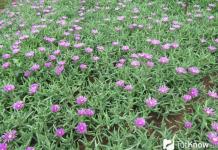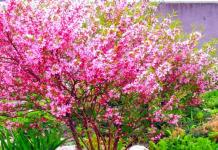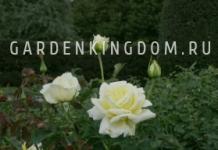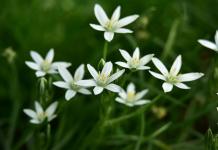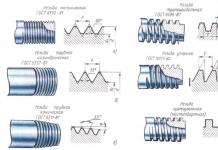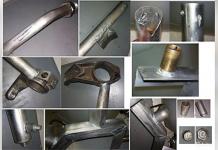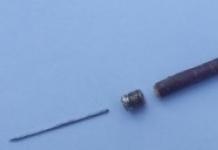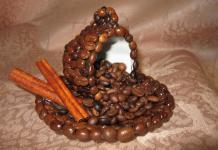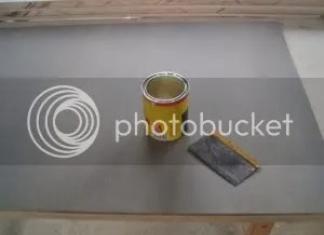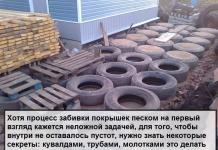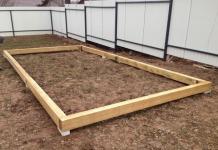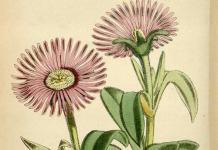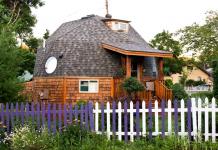Delosperma (lat. Delosperma) is a genus of wonderful succulent flowering plants of the Aizaceae or Aizoon family (lat. Aizoaceae) with an interesting shape of flowers and leaves. The name consists of two words meaning "explicit" (Greek delos) and "seed" (Greek sperma) due to the rather large size of the seed box of the plant. A feature of Delosperm is the release of shiny, ice-like calcium crystals, for which it is called the "ice plant".
Description
Representatives of the genus are perennial semi-shrubs, in which the base of the stem becomes stiff, and herbaceous ground cover annual and perennial plants. They grow in the wild mainly in the sultry climate of Africa. Most often very thermophilic, but there are also cold-resistant species. Plants are short (about 15 cm), growing up to 45 cm in diameter.
delosperma
The root system is fibrous, short, fleshy, there are tuberous formations on the roots to store moisture. Stem with tuberous thickened base, short, densely branched. There are a lot of succulent leaves, they are cylindrical or flat, lanceolate, obtuse, fleshy, sessile, have papillae.
Delosperma flowers are medium in size (about 2-5 cm), with numerous thin petals of bright color (red, pink, purple, purple, yellow, orange, white), shiny, in the form of baskets, similar to stars. The fruit is in the form of a large dry box, consisting of a large number of nests, the seeds are small. It blooms in May-September, the flowers are open in clear weather, and in the absence of the sun are closed.

The structure of the delosperm
Species widely used in floriculture
The genus includes, according to the latest data from the international registry, 175 species. The use of delosperma in culture began in the second half of the 18th century. About 15 species have become widespread as plants for gardens, flower beds and rockeries. The Czech florist studied the properties of many species, among which he singled out the most decorative and cold-resistant:
D. cloudy(lat. D. nubigenum) is one of the most frost-resistant representatives of the genus. The height of the shrub reaches 10 cm, the leaves are small oval. At low temperatures, they change from green to bronze. Very expressive star flowers from amber to fiery orange.
D. Cooper(lat. D. cooperi) is a low shrub covering an area of about 1 sq.m with fleshy succulent foliage. Many bright magenta-purple flowers 5 cm in diameter are similar in appearance to the basket inflorescence. They are located on low shoots.

Delosperma in an unusual flower garden
D. twisted(lat. D. congestum) - a very hardy species. The height does not exceed 10 cm, therefore, during the flowering period, foliage is practically not visible. A continuous flower carpet is formed. Flowers are very similar in appearance to daisies, usually bright golden in color. When they fade, the plant does not lose its attractiveness. Beautiful juicy foliage is also very decorative.
D. Sutherland(lat. D. sutherlandii) is distinguished by very delicate fluffy flowers with a light halo inside and a yellow center. The foliage is glossy and dark green in color.
D. Dyer(lat. D. dyeri) - one of the most luxurious flowering species. The flowers are very large, rich carmine color. And the smooth shiny surface of the petals only emphasizes its beauty.
D. floriferous(lat. D. floribundum) blooms in the first year of sowing. Its whitish-green foliage, combined with numerous light lilac flowers, will create a lovely picture of flowering in any flower bed. The plant is quite winter hardy.
Also popular are various varieties obtained by hybridization of the above species. For example, it was possible to obtain varieties with white (‘White Nugget’) and two-color flowers (‘Fire Spinner’).
Photogallery of species
Cultivation and care
Delosperma does not need fertile soil; light, non-acidic and well-permeable soil is preferable. The site is necessary with a sufficient amount of light and heat, having protection from cold air. Measures are required to prevent waterlogging of the soil. It is desirable to add sand or gravel to the soil for growing delosperma.
The plant is exceptionally drought tolerant and can grow well in high ambient temperatures. In conditions of insufficient lighting or an excess of nutrients, the delosperm is strongly stretched and partially loses its attractiveness.

Delosperma Dyer
Delosperma care consists of the following operations:
- moderate watering in the morning during a drought after the soil has completely dried;
- weeding from weeds and loosening the soil;
- mulching with leaf humus and stone chips;
- fertilizing with mineral fertilizers during the flowering period;
- pinching the top of the plant, which stimulates the growth of side shoots, thinning a large number of shoots and removing damaged ones. Also remove wilted flowers if there is no need for seeds.
Delosperma is a southern plant that most often does not winter in temperate latitudes, so it can be dug up and stored until spring in a bright, dry, relatively warm place or grown as an annual. The exception is a few species that successfully tolerate frosts of about -15 ° C without any protection or under cover, the main condition is to prevent stagnant water in the area.

reproduction
Delosperma can be propagated using seeds or cuttings.
To grow delosperma from seeds, in early spring (March-April) in a greenhouse, they are scattered over the surface of moistened loose soil, lightly pressed and covered with a film. Seedlings germinate at a temperature of about 20 ° C in two to three weeks. Landing on open areas is carried out in May.
When delosperm is propagated by cuttings, young shoots are used, which in the spring are carefully separated from the stem of an adult plant and planted in moist, loose soil, watered after it dries slightly, they take root easily.

Delosperma cuttings for planting
Diseases and pests
Delosperm under favorable conditions is distinguished by good disease resistance, it suffers only from excessive prolonged waterlogging (rotting of the root collar). The most commonly affected are aphids, mealybugs and spider mites. They are destroyed by treatment with special preparations.

Minimalistic rockery
Use in landscape design
The plant is distinguished by numerous silky flowers and the ability to cover areas with exotic decorative rugs, retains its decorative effect for a long time, is ideal for dry sunny rocky places, a welcome inhabitant of rockeries and rock gardens.
Good neighbors of delosperme in a flower bed will be low light-loving plants similar in terms of growth that do not require abundant watering (purslane, young, sedum, etc.).
South Africa.
flowering time
Late spring, summer.
Delosperma types
Cooper
Creeping, draft-resistant perennial succulent or semi-shrub with outstretched branches. Soft, fleshy, semi-cylindrical green leaves up to 5 centimeters long. Perfect for a rock garden or other landscaping.
It is an excellent ground cover plant. Brilliant, radiant pink-purple flowers up to 2 centimeters across, with white stamens. Blooms all summer.
Photo of a delosperm cooper flower.

cloudy
This kind forms a carpet from fleshy, evergreen shiny leaves, among which in late spring you can see many star-like small flowers. An excellent choice for hot, dry regions. Good as a groundcover, in a rock garden or on a wall, to form borders or as a lawn substitute.
Attractive to butterflies. Easily propagated by simply breaking off small pieces. They are easy enough to stick into the ground. New roots will appear in just a few weeks. Foliage turns bronze in autumn.

profusely blooming
This type forms many evergreen leaves and small stars of pink flowers with white stamens all summer long. It is an excellent groundcover for hot, dry slopes and will tolerate poor, sandy soil. It grows well in tubs and mixed containers, in rock gardens or used to form borders.

twisted
In delosperma twisted, as in the species listed above fleshy, evergreen leaves. Flowers in the form of small yellow stars. In winter, the leaves turn dark burgundy. Prefers light shade in the afternoon. In winter, good drainage is required, otherwise the plant will rot.
Good for a rock garden, rocky or alpine depression. Easily rooted in early summer.

Sutherland
An excellent perennial for the rock garden. undersized succulent with dark green, needle-like, shiny leaves that turn red in bright sunlight. From late spring it blooms with large, daisy-like bright pink or light purple flowers with yellow stamens. Blooms until early autumn.

Home care
Delosperma is evergreen outdoors only in temperate parts of zone 7. When growing in containers, protect from waterlogging and hard frost. The best place for wintering, planted in containers is a cold and dark room with a low level of humidity.
Over watering will kill the plant. When growing in the garden, make sure that the soil is well permeable. The plant should not be in water. Delosperm requires a well-lit place for normal growth.
Soil and planting
Light, well-drained soil will ensure good growth of delosperma. Container grown plants require high quality soil with an equal amount of coarse sand to provide drainage.
If planted in the ground outdoors, then the plants should be located thirty centimeters from each other. Only in this way will they receive the conditions for normal growth. When growing in containers, make sure the pot has drainage holes.

Lighting
Delosperme bright sun required otherwise the flowers will not open. In the room, bright, direct light from the southern or western windows is suitable. Outdoors, the plant needs sunlight all day. In a hot climate, bright sun is needed in the morning, and a little shade in the afternoon.
Watering
Delosperma after rooting needs very little watering. Thorough watering after planting helps initiate plant growth.
After that water only after extended dry spells. In the summer, outdoors, after two weeks. In winter, let the soil dry out before watering the plant again. Water indoors every two weeks.
Water at the end of the day, but so that the leaves have time to dry before night falls. This is necessary in order to avoid fungal infections.
Air humidity
delosperma undemanding to air humidity. In summer, you can spray water near the plant.

Temperature
In summer up to 40 degrees. When grown indoors in winter 10-12 degrees. It can withstand a slight increase or decrease in air temperature for a short period.
pruning
tall plants can be trimmed or pinched to stimulate growth. Trim or pinch above the leaves.
Remove flowers that have wilted to encourage new blooms.
Remove dead, limp or diseased leaves.
Remove some leaves during transplanting to relieve stress.
Destroy diseased parts of the plant.

reproduction
Delosperma takes root anywhere it touches the soil. So, carefully lift up each stem that surrounds your plant and see if it has roots already, and the roots may be all along the length of the stem.
If there are roots. You just have to separate the part with the roots and plant it in a pot or in the garden. If the roots are in several places, then divide the stem into several parts and plant each of them. If a part of a plant has roots and leaves, it can grow as a separate plant.
If there are no roots on the stem, you can still plant it. Fill a plastic pot with sand, sandy soil, or cactus potting soil. Cut off a 5-7.5 cm stem, plant in a sandy mixture and place in a sunny place. After watering, roots will appear within a few days.
Delosperm cuttings are usually propagated in spring or summer, although it can also be propagated by seeds.
When you take a cutting from a mother plant, dry it for several hours to form a protective film on the cuts.
Transfer
Plants grown in pots transplanted once a year in spring before the start of growth. In most cases, delosperma grows less intensively in winter, so it is possible to transplant at the end of winter.

Fertilizer
Most plants need a regular diet from a complete complex fertilizer. It should be either special, designed specifically for your type of plant, or general, with nitrogen, phosphorus, potassium.
When using a water-soluble fertilizer, follow the instructions on the package.
Using a granular fertilizer, spread a small amount under the plant from the stem to the edge of the container or branches if the plant is outdoors.
Water slowly and thoroughly.
Never over fertilize. The leaves will become weak, there will be few flowers. Delosperma blooms better if there is no overdose of fertilizers.
rest period
Winter months at 10-12 degrees.

Diseases and pests
There are very few problems that can arise when growing delosperm. During propagation or fertilization there may be damage from the larvae of the mushroom midge. Also, the most common pest is the aphid. Leaf and root rot can also be a problem for delosperm lovers.
The appearance of leaf and root rot easy to avoid if you organize proper watering and prevent overwatering and moisture stagnation. Diseases and pests can be avoided by carefully inspecting plants and taking the necessary measures in time.
The plant got its name due to its flowers that shine in the sun and completely cover the foliage. Originally from South Africa, delosperma thrives in many regions of the world with minimal care.
Plant rarely grows over 60 centimeters in height. However, it grows in breadth, ideally covering the soil.
Aizovye family (Aizoaceae), naturally growing on the African continent. Beautifully flowering crops, used in and.
- Family: aiz.
- Homeland: East and South Africa.
- Rhizome: fleshy.
- Stem: branched, sometimes woody.
- Leaves: lanceolate, succulent.
- Fetus: box.
- Reproductive ability: propagated by seeds and vegetatively.
- Illumination: photophilous.
- Watering: does not tolerate waterlogging.
- Content temperature: thermophilic, there are frost-resistant species.
- Bloom time: May to September depending on the species.
Description of the delosperma flower
Perennial succulent shrubs or ground cover grasses 10–30 cm high, with branched or creeping stems and fleshy elongate-lanceolate leaves, green or bluish-green, smooth or covered with bristles, in some representatives with pointed papillae. Because of the shiny calcium crystals that stand out on the surface, outwardly similar to ice floes. The delosperm flower is sometimes referred to as the "ice plant".
The roots are fleshy, with nodules or thickened rhizomes that serve to store moisture.
Delosperma flowers are white, pink, purple or yellow, star-shaped, often with shiny petals, up to 7 cm in diameter. They close at night and in bad weather, protecting the pollen from getting wet. They bloom profusely and for a long time, some species - from late spring to autumn.
Delosperma in the photo
The fruits are multi-celled capsules that open only when moisture gets on them and scatter very small seeds at a distance of no more than 1.5 m, which explains the narrow distribution area of the plant in nature.
Delosperms: popular types and varieties
There are more than 100 species in the genus. Most of them -, some mountain varieties can be grown in the gardens of the middle lane. Below are descriptions and photos of delosperms recommended for open ground.
Delosperma profusely flowering (D.floribundum), one of our most common species, with bluish-green leaves and numerous pink flowers with a white center up to 3 cm in diameter, blooming in June. It blooms in the first year after planting, so it can be grown as an annual. There is a frost-resistant variety - delosperma "Stardust" (Sturdust), up to 10 cm high with large, up to 5 cm, lilac-violet flowers, hibernates under cover.
Delosperma Cooper (D.cooperi), a compact bush up to 15 cm high, with grayish-green cylindrical leaves, decorated with numerous papillae. Flowers pink-lilac, up to 5 cm in diameter. In mild climates, it hibernates without shelter.
A number of hybrids and varieties have been bred, among them:
Dark purple John Proffit.
Salmon pink Kelaidis.
Frost-resistant forms:
Fuchsia pink Table Mountain.
Dwarf pink Mesa Verde.
Delosperms are less common in gardens:
yellow crowded (D. congestum).
Golden or orange cloudy (D. nubigenum).
Dwarf species with attractive leaves, more winter hardy than those described above.
Cultivation of delosperma
To grow Delosperm successfully, provide full sunlight and loose, well-drained, non-acidic, nutrient-poor soil, preferably with the addition of gravel or sand.
In the shade or with an excess of fertilizer, it stretches, blooms not so profusely. It is drought-resistant, but in hot dry weather requires regular watering without stagnant water. Flowering bushes are fed with mineral fertilizer once every two weeks.
Delosperma is planted on southern slopes, in rocky gardens, and is suitable for growing in pots, containers and balconies. Frost-resistant species hibernate under air-dry shelter (fir branches, wooden box), they suffer more not from low temperatures, but from damping out during thaws. When grown in containers, they can be placed in the basement or on the windowsill for the winter.
The flower is propagated by seeds, which are sown in March-April for seedlings, or by cuttings. Cuttings take root well, are harvested in the spring, when grown in a room - all year round.
Delosperma flower (Delosperma) belongs to the genus of low-growing succulent ground-blooded plants of the Aizov family, containing more than 170 varieties. In the wild, this culture grows in the expanses of South Africa, mainly in its eastern part. In the middle lane, it is cultivated as an annual or as a houseplant.

Delosperma is a perennial creeping grass or shrub with a woody stem base. The ground part of representatives of this genus is never higher than 0.1-0.3 m, but sprawling and branched, it can grow in breadth up to 0.4-0.5 m. Creeping and flattened branches often take root at the nodes.
The root system is short and fibrous with small oblong tubers or thickened fleshy rhizomes that serve to reserve and store moisture. Due to this, the plant is able to withstand long dry periods.
Most varieties of this crop have narrow, lanceolate, slightly curved leaves up to 4 mm thick, which are often mistaken for stems. The color of the ground part can vary from bluish-gray to dark green. The surface of leaf blades in some species is shiny and smooth, while in others it is covered with short villi. Through the stomata on the leaves, small crystals of calcium salts stand out, which glisten in the sun and look a bit like frozen ice.
Delosperma flowers reach 70 mm in diameter, consist of a large number of thin narrow elongated petals, located in one row or in several layers. In the center, smaller and thinner petals are formed in the form of a ball, which makes the flower voluminous.
The color can be very different: pink, purple, white, yellow, salmon, lilac, purple, etc. Delosperma blooms from May to October. In cloudy and rainy weather, as well as at night, the petals close. With the first rays of the sun, they open again.

The most popular among flower growers and landscape designers are the following types and varieties:
- Cooper's delosperma (delosperma cooperi). A compact bush grows no more than 15-16 cm in height, up to 45-60 cm in width. The bluish-green paired leaves are thick and fleshy, similar to narrow cylinders, densely covered with growths-papillae. Small basket-shaped inflorescences (3-4 cm in diameter) of purple or lilac-pink color with a creamy yellow core cover the plant with a dense colored carpet. Alpine frost-resistant species, withstands temperatures down to -17 ... -20 ° С.
- Delosperma twisted (delosperma congestum). Low (up to 10 cm), slow-growing bush with dense juicy bright green foliage, which acquires a maroon hue in autumn. A large number of golden yellow flowers almost completely covers the plant. It tolerates frosts down to -20 ... -23 ° С.
- Delosperma cloudy (delosperma nubigenum). A low groundcover creeping plant about 5-7 cm high with small (1.3-1.8 cm) thick oval dark green foliage that changes color to bronze-brown in the cold season. Orange or bright yellow star-shaped inflorescences bloom in May. The diameter of the flower is about 3.5-5 cm. The most frost-resistant species, can withstand temperatures down to -23 ° C.
- Delosperma floribundum (delosperma floribundum). A low (up to 10 cm) bush, growing up to 25-30 cm wide, with bluish-green leaves 2.5-5 cm long and numerous light pink flowers up to 3 cm in diameter. It dies even with short-term slight frosts down to -5 ... -7°C.
- Delosperma stardust. Frost-resistant variety of profusely flowering delosperma. A low-growing miniature plant no more than 10 cm high with many star-shaped inflorescences up to 5 cm in diameter. Narrow petals are painted in a juicy pink or lilac-purple hue, turning white closer to the center. Maintains the lowered temperatures to -29 °C.
- Variety Twinkling Stars, bred on the basis of profusely flowering delosperm. A relatively tall bush (up to 20 cm) with star-shaped single-row flowers of rich purple, yellow, lilac or red hues with a white fluffy center.
Read also: Growing ampelous dichondra
How to propagate delosperma
The culture propagates by 2 methods:
- seeds;
- cuttings.
Growing delosperma from seeds for seedlings at home
In most cases, delosperma has to be planted in the ground every year anew, because it freezes out in the cold. In order for the bushes to bloom earlier, the plants are grown through seedlings. Sowing is done in winter (January-February).
The process of obtaining seedlings is as follows:
- To increase germination, seeds must first be stratified. A light sand-peat mixture is poured into the bowl, on top of which a layer of snow is laid.
- The snow is leveled and seeds are scattered on top. When the snow melts, the substrate will be saturated with moisture that has appeared, and the seeds will be pulled inward.
- The container is placed inside a plastic bag or covered with a film. Then placed on the bottom shelf of the refrigerator in the vegetable compartment. You can simply bury the dishes deep in a snowdrift and leave there for 2-3 weeks.
- The container is removed from the refrigerator or snow shelter and, without opening, put in a warm and well-lit place for another 10-12 days.
- After the appearance of the first shoots, the film is removed, the soil is carefully moistened.
- Seedlings dive into individual containers after the appearance of 4-6 leaves.
- When the threat of night frost has passed, the delosperma seedlings are placed in a permanent place in the open field. Pre-hardening is recommended.
Natural stratification is possible if seeds are sown in autumn before winter or in early spring immediately into the ground.

Cuttings can be separated from the mother plant throughout the growing season. They are rooted in containers with water or planted in small individual pots. After the formation of a good root system, mature seedlings are placed in the right place.
How to care for delosperma?
The process of caring for this culture is not particularly difficult, given some of the features of the content. It is drought-resistant, but in hot hot weather it needs to be watered abundantly. It is extremely important to prevent stagnation of moisture so that the root system does not rot.
Read also: Features, cultivation and care of hybrid aquilegia
Where to plant?
Delosperma requires well-lit, warm and open sunny areas for placement. The plant loves the sun and a hot, dry environment. In the shade, the bushes lose their decorative effect, stretch out and bloom poorly.
Suitable soil
The culture adapts well to any soil. The main condition is good drainage and the absence of moisture stagnation. To loosen and dry the soil, it is recommended to first dig it with the addition of sand or peat. The distance between individual bushes should be at least 40-50 cm, because they quickly spread and grow in width
top dressing

To ensure rapid growth and abundant flowering, delosperm should be regularly fertilized with a frequency of 1 time in 2-3 weeks. Any complex mineral fertilizers for flowers will do. It is necessary to water carefully, avoiding the accumulation of water in the axils of the leaves and the formation of puddles on the ground. Otherwise, the leaves and the basal neck may rot.
Diseases and pests of delosperma
Delosperma bushes are sometimes attacked by the following pests:
- spider mite;
- mealybug;
To combat them, various insecticidal preparations are used.
Diseases culture is extremely rare. In case of violation of the irrigation regime and poor drainage, various rots may appear. In this case, it is necessary to normalize the humidity regime and remove the rotten parts of the flower.
Preparing for winter
Winter-hardy delosperma varieties are able to easily withstand temperatures down to -15°C. For them, long spring periods, when the soil is very wet, as well as alternating frosts and thaws, are much more dangerous. In such conditions, the bushes rot. It is recommended to build a frame (cardboard box, wooden box, etc.), cover it with plastic wrap, and on top with insulation (dry leaves, spruce branches, etc.).
Varieties cultivated as annuals do not make sense to insulate, because they will freeze anyway. In late autumn, the site is dug up, and dead stems and rhizomes are removed. Potted houseplants require a dormant period during which they stop feeding, severely reduce watering, and place flowers in a moderately cool but well-lit area.
Delosperma is a large and diverse genus of succulent shrubs. These short plants with fleshy stems and foliage have vibrant, multicolored petals that sparkle in a unique display in a flowerpot or garden.
Description
A plant of the Aziz family came to us from South Africa. It is widely distributed from Madagascar to Zimbabwe. Among more than a hundred species, there are ground cover plants and semi-shrub forms. At home and indoors, they behave like perennials, but only a few varieties survive the winter outdoors.
Delosperma rhizome is fleshy and branched, goes deep into the soil in search of moisture and nutrients. On long thin threads of roots, small oblong tubers are formed. The ground part does not grow much in height and ranges from 10 to 30 cm. The stems are highly branched and easily bend to the ground. Leaves lanceolate, curved, up to 4 mm thick. The color of the ground parts is dark green, bluish. There are smooth or slightly fleecy varieties. Crystals of potassium salts often appear on the surface of the green parts, which gives an icy appearance to delosperm.















From May to the beginning of autumn, the delosperm is densely covered with flowers. They have thin, elongated petals arranged in one or more rows. A small ball of the same petals is formed in the center, which gives volume to the core. The color of flowers can be white, yellow, pink, scarlet, salmon, purple or lilac. There are specimens with gradient colors, when one petal at the edge and base has a different color. The diameter of one flower reaches 7 cm. The buds tend to close in rainy or cloudy weather and open again towards the bright sun.
Delosperma seeds are interesting. After the flower wilts, a small round box with many nests ripens. When moisture (dew or rain) gets in, the box opens on its own, scattering the smallest domes of seeds at a distance of up to 1.5 m.

Varieties
Among the wide selection of delosperma, it is worth noting separately several varieties that are especially interesting for growing in our country.

cultivation
Many delosperma varieties do not survive temperate winters, so the issue of its reproduction remains relevant. The most convenient way is to plant seeds. In order for the plant to grow stronger and bloom, seedlings are pre-grown.
To ensure natural stratification for the seeds and speed up the emergence of seedlings, clods of snow are evenly lined in a container with light peat soil, and seeds are already poured on them. The melted snow moistens the soil and pulls the seeds inside. After the snow melts, the container is placed in a bag or covered with a film and placed in the refrigerator for 2 weeks. Then the box is placed on the windowsill and the first shoots are expected within 10-12 days. After the appearance of sprouts, the shelter is removed and the soil is carefully moistened. With the advent of 4-6 true leaves, picks are made in separate pots and planted in open ground a week later.
All year long, when grown indoors (or during the summer season when grown outdoors), cuttings can be separated from an adult plant. They are immediately placed in the soil, carefully watered and waiting for rooting.

Care
Delosperma is photophilous and needs warmth, so the warmest and sunniest areas are chosen for it. She is not afraid to stay under the open sun even in intense heat, but she suffers from dampness and excessive shading.
For planting choose neutral fertile soil without stagnant water. You can additionally add sand or peat to the hole before planting. With the transplantation of seedlings in open ground, they do not hesitate. Such a highly branched plant grows quickly and needs room for roots and ground shoots. Between plantings maintain a distance of 40-50 cm.

In order for rooting to proceed actively and more buds to form, every 2-3 weeks the delosperm is fertilized with mineral fertilizers. When watering, care must be taken so that water does not accumulate in the axils of the leaves, and puddles do not form on the ground. This contributes to the decay of the basal neck and foliage.
For the winter, plants need to provide shelter. Even frost-resistant varieties suffer from slush and dampness during thaws, so you must first build a frame, cover the shoots with a film, and then with heaters. Those varieties that are cultivated as annuals do not cover. In deep autumn, you can dig up the ground and remove dead stems.

When grown indoors in winter, fertilizers are not applied and watering is significantly reduced. It is recommended to place the pot in a moderately cool, lighted place.
Usage
Delosperma is used as a spectacular groundcover. Not too rising above ground level, it decorates the lawn with a continuous flowering carpet.
The plant is used in rockeries and rock gardens, suitable for decorating balconies and ampelous compositions. It looks spectacular in combination with petunia, lobelia, chistets, stonecrop and even low coniferous plants.










